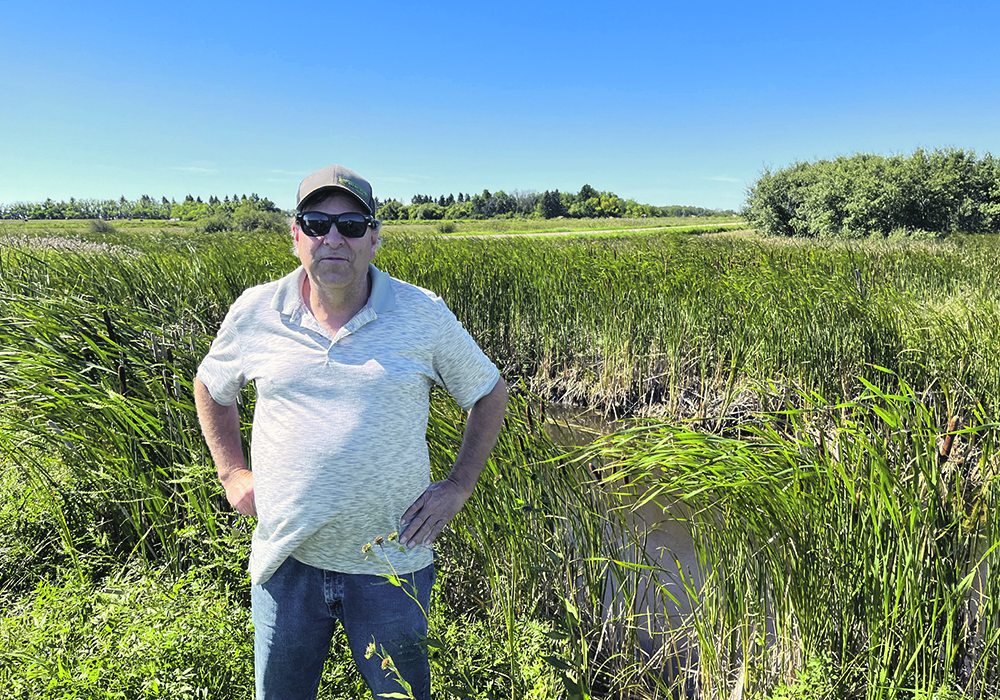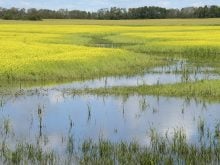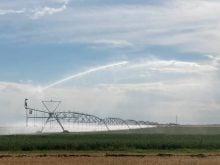Water quality is the latest concern for one Saskatchewan downstream landowner who receives water from a large area
WAWOTA, Sask. — Lane Mountney doesn’t want his neighbours’ water.
However, one quarter section of his land in southeastern Saskatchewan was designated the adequate outlet for a 28-quarter drainage project and, even though the Water Security Agency hasn’t approved the project, the water has already started to arrive.
Related story: Network promotes better farm drainage communication
Read Also

Russian wheat exports start to pick up the pace
Russia has had a slow start for its 2025-26 wheat export program, but the pace is starting to pick up and that is a bearish factor for prices.
The trenching from upstream landowners in the Rural Municipality of Wawken has already taken place, and once the water reaches Mountney’s land, it continues through a creek system and affects others downstream.
One of his neighbours said he is losing pasture and another said he is prepared to build dams to keep the water from his land.
This is not a new issue in Saskatchewan. Agricultural drainage has been contentious for decades.
In the last 10 years, the province introduced new regulations and an agricultural water management strategy in an attempt to bring unauthorized drainage into compliance and stem complaints from those affected by excess water.
Mountney said this hasn’t changed the situation.
“It’s made to create problems with neighbours,” he said.
He has a box full of documents, mainly copies of correspondence between him and his wife, Sandra, and various WSA staff, which indicates their opposition to the project. However, they say the WSA doesn’t listen and isn’t concerned about people like them.
The WSA would not comment on the Wawken project except to say it has “not received any water quality samples from landowners related to that project.”
“Drainage is an important tool for producers to manage water on their land. When done responsibly, it supports economic growth through effective water management, while also maintaining water quality, safeguarding some wildlife habitat and reducing local flooding impacts,” the agency said in an emailed statement.
“All drainage works require an approval from the Water Security Agency. This process is designed to manage impacts to water quality, amongst other factors.”
The RM of Wawken did not comment on the project, and one landowner within the network said he didn’t want to comment because only one person was opposed to it.
To be clear, Mountney said, he is not opposed to all drainage. He’s done it himself in small amounts on his own land.
However, he said the volume coming through the adequate outlet and into smaller creeks is just too much. Two years ago his horse pasture flooded and the family stopped using its well, which is on high ground, because the water turned yellow. He said the water rose up from the ravine to the door of his shop.
This year, University of Regina staff sampled the water at two locations on Mountney’s land: the adequate outlet and the creek at his home, and found it contained above acceptable levels of phosphorus, conductivity and salt and very low levels of dissolved oxygen. He was advised not to allow cattle to access it.
Kerri Finlay, a biology professor and co-director of the U of R’s Institute for Environmental Change and Society, said more testing would be required to prove that drainage was solely responsible for the poor quality, but there is “overwhelming evidence” that wetland drainage causes deterioration.
“Nutrients and salts, in particular, increase downstream of areas where wetlands are lost, and all of the environmental benefits of wetlands are removed from the landscape,” she said.
A table summarizing the project area indicates 880 wetlands covering 586.5 acres. Of those, 366 wetlands covering 244.2 acres are completely drained, 38 covering 191 acres are partially drained and 369 representing 60.3 acres are farmed. The 94 remaining intact wetlands account for 88.7 acres.
The table also notes the largest completely drained wetland was 47.4 acres and the largest partially drained wetland is 44.1 acres. The largest intact wetland was just shy of 10 acres.
Mountney said the landowners draining most of the water are draining seven wetlands that are more than 10 acres each.
“They need to retain that water,” said Mountney.
He doesn’t have cattle but he knows many downstream who do. The results of his water tests have him urging them to test their water, too.
Wade Porter is a mixed farmer south of Mountney and a councillor in the RM of Walpole.
He said when he heard about Mountney’s water tests, he wondered if that’s why his yearlings haven’t done well the last couple of years.
He switched from a cow-calf operation to running 450 yearlings on grass and has noticed they aren’t gaining well. They run on three pastures with dugouts connected to creeks that accept drained water.
“The last two years here, since I’ve gone to yearlings, my weight gain has been very, very low, and that’s what makes me think I’d better be testing my water,” he said.
Porter said other factors could be at play, but even this year with adequate moisture and hay, the yearlings still did not do well.
Another neighbour, who did not want to be identified because of the tension around the issue, said he would also be testing his water. His pastures have been flooding since the trenches were dug.
He said the creek through his land can handle a rainfall of up to 90 millimetres.
“But 12 to 24 hours later all the water from that drainage system is all hitting us at our place and that amount of drainage is going over the banks. It floods out and it doesn’t run back down into the creek,” he said.
It’s killing the grass and replacing it with foxtail.
He and others said the creek depth and width vary as it moves through the landscape, so each is affected differently.
“I would like to see the project that they were proposing to slow this water down,” he added.
“I don’t think it’s a bad idea as long as it’s policed properly, which I don’t know if they have the capability of doing that.”
He said the WSA told him it wants landowners to indicate how much water they want to drain so it can design a system to handle it.
“But what has happened here is most of the drainage has already happened and now they’re going back to try and fix it.”
He said the goal should be to get the system back to the way it was before the drainage trenches were dug and slow down the water.
“Then it shouldn’t matter for anybody downstream, but at the moment it is affecting downstream because they haven’t got it in place yet.”
Rural municipalities are facing significant infrastructure challenges because of drainage, including mushy roads and the expense of larger culverts.
At the Saskatchewan Association of Rural Municipalities annual convention last year, the membership passed a resolution to lobby the WSA to “hold those initiating the drainage activities responsible and to enforce actions to remediate all the unapproved drainage activities on those that are responsible for facilitating the work.”
The resolution noted that the works are built within municipal infrastructure and on private lands without the WSA’s permission. The WSA responded by noting that Requests for Assistance can be made to bring works into compliance or close them.
Mountney has filed nine of those; seven were accepted but there has been no resolution.
In the RM of Martin, Hal Garrett said he is “certainly not standing as a beacon against drainage,” but he said everyone should have to follow the same rules: apply for permits and wait for approvals before moving forward.
“It just leads to all kinds of battles within the RM and downstream, and the concerns that people have downstream aren’t being addressed,” said the councillor.
“The damage is done when the trench is done.”
The RM has had to install bigger culverts in some places to accommodate the water coming from other municipalities. Those who are draining upstream are forcing everyone downstream to accommodate them, Garrett said.
RMs, including Wawken and Martin, have spent thousands of dollars working with former watershed associations and the WSA on potential drainage approval projects, but those approvals are still outstanding.
Garrett said likely two-thirds of RM councils are dealing with water issues of some type.
“Our council has gotten better at stopping projects, but you still get the back door stuff, the trenching that happens when no one’s looking,” he said.
“The government or the Water Security Agency says, ‘well, if they’re just draining off into a water run and it’s just on their own land, it’s not a problem.’ But the fact is they are increasing the volume that comes down that creek, and each creek merges to a bigger creek.”
He would like to see a plan to have people retain water on their own land. That idea was part of the WSA plan several years ago.
Garrett said downstream landowners like him are also forced to trench if they are accepting everyone else’s water.
He said a landowner told him he would have to be like everyone else and buy a track hoe.
“Is that a solution? Maybe it is, but it’s not helping the overall situation, and it’s not a realistic solution,” he said.
Porter’s solution might be to build berms on his property to keep the water out, he said. The creeks that some see as deep natural waterways flatten out on his land, leaving the water landlocked and him to deal with it.
“There’s just no respect, no thoughts for the neighbour, and it’s kind of frustrating,” he said.
Porter said RM councils have to deal with many issues because so much bush has been destroyed and people continue to trench.
“I’ve lived here 55 years and the landscape has changed so much we’ve got issues on both hands, winter and spring,” he said. “The snow now is blocking main roads where it never used to because it was always slowed down from bushes. We’ve got problem areas where we’ve never had them before.”
He said everyone talks about the various drainage projects and bylaw infractions in their regions, but few want to do anything about it. He said he has had to shut down some neighbours’ activities because they were against bylaws and lost some friendships as a result.
“I guess everybody wants to be warm and fuzzy,” he said.
“You don’t want to have enemies. You’re in a small community. But what I always says is, if they don’t want to respect the rules, I guess your friendship wasn’t very strong to begin with.
“It’s just greed. I guess that’s their progress, but you’ve got to think of your neighbours.”
















